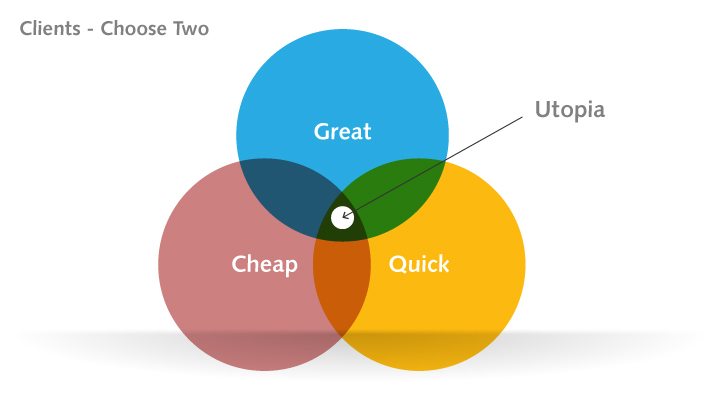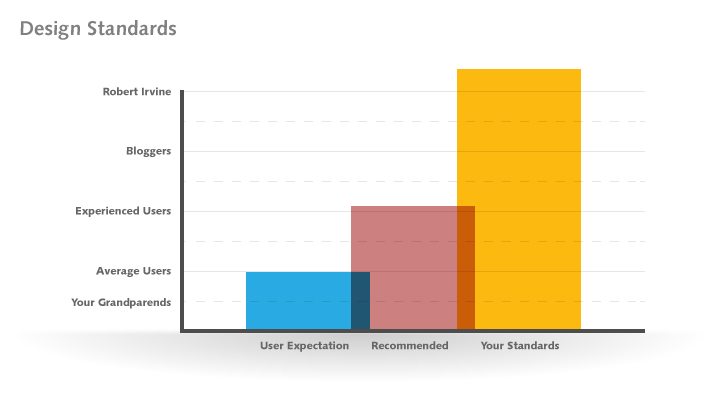Treat Every Release as if It Were Your Last
Since the beginning of time, the design process has remained mostly the same. Design comes before development. Talented designers pour over examples, studies and hypothesis to produce something deemed worthy of releasing. However, since the old days, a lot has changed in the way we build things, especially in software development.
With the lean revolution upon us, people have traded isolation rooms and waterfall planning charts, for open spaces and continuous delivery. As tough as the transition has been on developers to find new methods and change mindsets, people often overlook the fact that the process has fundamentally changed for most designers. But in a world where test and learn is the law, we’ve created a battle between quality and deadlines. That’s why I urge every designer I meet: treat every release as if it were your last.
Is Running Lean Running from Quality?
In the books The Lean Startup and Running Lean authors Eric Ries and Ash Maurya stress the value of using The Scientific Method. Create hypothesis, release something to test if a hypothesis is correct, evaluate the results and then using the learnings to refine and repeat. This is a new concept being introduced to Designers.
I’m not talking just about running usability tests or holding focus groups, but using our instincts, along with examples and our education to guide us, then releasing directly to customers. Sound crazy? We’ll I am crazy, crazy like a fox. And from what I understand “crazy like a fox” is a way of saying that you’re not crazy.

Clients – Choose no more than two things.
Typically, designers like to show our our clients a three circle chart, the one the one where they can choose two things out of the three that they want. The circles read “Fast”, “Great” and “Cheap”. The inherent problem is evident to anyone who works internally at a company or startup. Cost is never a device an internal designer can use to put pressure on their organization. So, without the pressure of cost, organizations will always expect things great and fast — a very difficult proposition to meet with every release. Inevitably this means you’re releasing something that you didn’t have time to put through the rigors of the classical design process.
Releasing something that you don’t consider “finished” is a horrible feeling. It’s one that after a while really started eating me from inside out. So I started making small changes in my processes and my mindset in order to help me adapt to this escalating pace.
The fact remains that business needs, in the end, out-weigh designer tendencies to want to release only the most perfect, portfolio worthy work. Now I know “the needs of the many” stuff sounds like something out of Star Trek, but imagine you’re in a start up company for a moment. If it costs you $100,000 per month to run your operation, and you’ve got less than a half-million dollars left in investor capital, do you have time to be worrying how responsive or future proof your designs are? Suddenly my Vulcan wisdom doesn’t seem so foolish.
Its Not a Waste, if They Have Bad Taste

We hold ourselves to “impossible” standards
The problem with being at the mercy of business value is that you have to let go of what you think is great design. Often times to test things, releases will happen to limited audiences, and won’t be blogged about on major websites. The expense of developing something for months in isolation in order to come up with the next utopian design is a big bet. It also drastically changes the amount of pressure on you to deliver the perfect solution. In the end it rarely pays off.
It’s a cliche that time is design’s natural enemy. If left to our own devices, designers would spend all the time they could making sure every last pixel is perfect, the entire design and flow is harmonious, and that it’s all on-brand and emotionally delightful. Hey, if you’re really a hot-shot you may have a bold idea toward the end of your process that dictates a fundamental shift in everything you’ve done so far.
But what’s the real value of developing something in a bubble? Every artist knows the sting of hearing that their work isn’t liked by an audience of people, but lean thinking requires a designer to make a conscious effort to not take user dissatisfaction as a personal gripe.
I’ll admit that there is something profoundly different from constructive criticism from a friend, colleague or director, and having a large group of people say they simply “don’t like” what you’ve made. Worse perhaps is a group of people telling you they actually love something that you did in a day, on the seat of your pants, and never had the chance to make look good. But, then again, people buy Ke$ha albums, so why should I be surprised…
There are things we need to realize that will help us stay sane in this not so sane world. Think of it as practicing the art of mindfulness. It informs our decision making, and helped me be more comfortable with my work.
The first is that your users aren’t as sophisticated as you are. That means they probably don’t demand the level of quality you’re capable of producing (not that they don’t deserve that quality, because they do.) The second thing is that it’s more important to learn than it is to get it right the first time. You’ll be wrong more than you’re right, and that takes courage to admit. The last thing to remember is that if you create success, you’ll get the time and resources to get it right eventually.
What if This Is Your Last Software Release?

The Design “Rot” Theory, Based on a Talk by Jared Spool.
The truth remains that these small tests may live in the wild for some time, and the priority to get them changed or improved may not be on the radar for the foreseeable future. That means living with something that is less than ideal, but effective for the purposes of testing. It may sit there and be adding to experience rot that plagues your product. Note that the graph above doesn’t list “Happy Users” anywhere, because that will depend on your market, your users, and several other factors.
The main takeaway is that engineers are happier when a product has a lot of bells and whistles, but designers are happier when user experience is at it’s peak — even if control and features are ceded. Your business is probably fine with walking the line between the two. Have enough features to sell against competition, but an experience that is keeping users satisfied. Experience rot is the gap between a products features and its user experience. So, here we are, designers, in charge of visual design and user experience for our respective products, with something that we don’t even like being used by customers. What we need to remember here is that it’s worth it.
It’s why, when we design something and develop it (or hand it off to developers), we should make an effort to comb over our designs with a discerning eye, and we should chase them down post development to check for quality and consistency. Not trying to ensure things are perfect, but rather that they are effective. Do our designs effectively test our hypothesis and is it something we can live with if we never get back to it?
Remember that one of the most important things to learn in lean thinking is that we’re going to be wrong, a lot. When I first realized this, my brain and my ego had a battle to the death, and I’m pretty thankful that my brain won. Mostly because I need my brain to make Ke$ha and Star Trek references.
What designers need to realize is that in this new world, our pride is misplaced. Instead of worrying about something being fawned over by our peers, we have to celebrate failure, being quick and dirty. We have to celebrate being wrong, learning fast and doing more. I’m not talking about abandoning user experience principals, I’m not even talking about releasing something that is embarrassing (though it may be to the perfectionist), I’m talking about realizing that our role has changed and so must our process.
The question we need to ask ourselves when it comes to the quality of our work is this: how would I feel if this were the last chance to get this feature right? Designers, treat every release as if it were your last. If you do that, then it probably won’t be.
At the risk of sounding like a curmudgeon, I put this concept to you, the reader. I’ve said enough (and you probably only skimmed this thing anyway). So, tell me, have you waged the battle between design and deadlines? Who usually wins, and what tactics do you you to keep yourself from getting discouraged and always trying your best to output quality design?